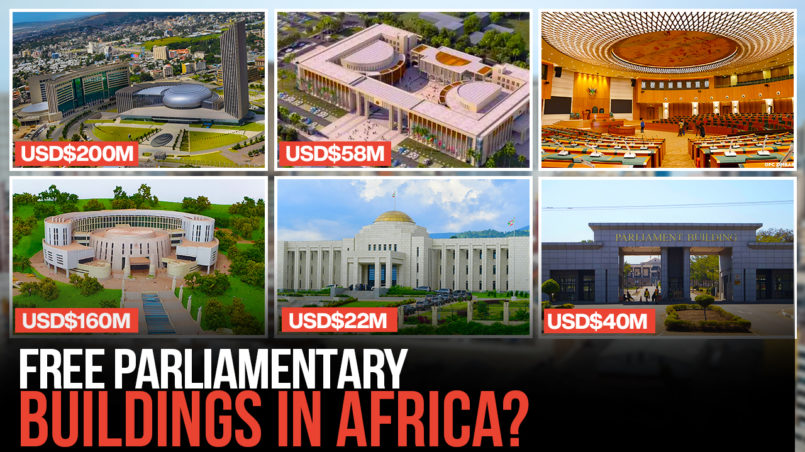Introduction
In 2013, China announced its Belt and Road Initiative which aims to promote economic development and inter-regional connectivity. One of its major objectives is to increase the infrastructural investments in developing countries and boost their global GDP. This includes the construction and development of ports, skyscrapers, railroads, bridges, airports, dams, harbors, and many more.
Over the past few years, China has been heavily involved in the construction of multimillion-dollar infrastructures across the African continent. The emergence of the rising superpower, as a major development funder in Africa, has been met with criticisms, particularly in instances where huge government infrastructures have been fully funded, built, and presented as gifts by China.
Is this a way for China to extend dominance in African politics or perhaps, China is just positioning itself as a trusted ally? In this video, we take look at some mega structures African governments have benefitted from China’s generosity.
Presidential Palace – Burundi
Burundi inaugurated its multimillion-dollar presidential palace in 2019. The building which is estimated to have cost $22million was fully funded and built by China and donated to Burundi to seal its diplomatic relations with the East African country. The new building is located in Gisenyi in the north of the capital Bujumbura. It sits on 10,000 square meters of land and has several facilities on its premises including circular roads, car parks, and sewer systems. The new edifice would host the presidency, two vice-presidents and their staff, conference rooms, and space for official ceremonies.
According to the Foreign Affairs Minister, Ezéchiel Nibigira, Burundi, since the independence has not had such a building and they thank the government of the Republic of China for it. But the question still looms as to why the world’s fifth least-developed country has prioritized a $22million building for the government?
Parliament Building -Lesotho
In 2012 the Lesotho government inaugurated a new parliament building which was funded and constructed by the Chinese. This follows a pledge China made in June 2007 to fund a new parliament for the Basotho people. The parliament complex is located at Mpilo Hill, outside the center of Lesotho’s capital Maseru.
The structure covers an area of 7200 square meters and includes a five-storey building that houses the National Assembly offices, a debating chamber, a reception checkpoint, accessory buildings, a parking lot, open grounds and others. The architectural design and construction were undertaken by China Construction Company including the furnishing which is all made in China products.
Parliament Building- Malawi
In May 2010, China handed over a $40million parliament building to the Malawian government. The structure is located in Lilongwe, the country’s capital.
The new parliament building has a capacity of 288 seats. The modern and high-tech facilities include CCTV security devices, offices, presidential suite, press gallery and public gallery, electronic voting system, LCD TV system, banking facilities, cafeteria, and a library.
The then Malawian President, Bingu Wa Mutharika described the building as a great milestone for the country and added that the modern technology and facilities that had been installed in the new parliament would offer a conducive environment for members of parliament to interface with the electorate and other interest groups.
Construction started in 2009 and was completed in 2010. The project was assigned to a Chinese Construction Company.
Parliament Building – Congo
Congo is another country in the sub-Saharan region to have benefited from China’s generosity. The country was gifted with a new parliament building estimated at the cost of $58million. The project is funded by the Chinese government for free.
In May 2017, Congolese President Denis Sassou Nguesso cut the sod for the commencement of work on the edifice which is located in the capital, Brazzaville. The opposition and some activists kicked against the move over fears that the Chinese investment might have an impact on Congo’s debt and said that focus should be directed to the stability of the country and the general wellbeing of its citizens.
The construction was entrusted to a Chinese Provincial Construction company for a scheduled period of 40 months.
Parliament Building -Gabon
Gabon’s National Assembly building was rehabilitated by the Chinese government. The building is located in Libreville, the capital of Gabon, and was originally constructed with interest-free loans from the Chinese Government. In 2016, the structure was set ablaze following the violence that erupted after President Ali Bongo was declared the winner of the 2016 elections. The Chinese government and the Government of Gabon signed an agreement that committed grant funding for the National Assembly Building Rehabilitation Project.
The project involved the demolition and reconstruction of the hemicycle, an extension of the building’s capacity to accommodate more members and deputies, the renovation and decoration of 205 offices, and the reconstruction of a fire pump room and a fire tank. The project was contracted to a Chinese construction and was officially handed over to the Gabonese government in 2021.
Parliament Building – Zimbabwe
Zimbabwe just receive a whopping $160million gift from China. The gift, which is the new fully funded parliamentary complex by Beijing is a show of solid friendship between China and Zimbabwe. The new parliament building is located at Mount Hampden Hill, a few kilometers from the capital Harare.
The structure sits on 33,000 square meters of floor space and comprises a six-storey office complex and a four-storey building. The new building replaces the old colonial structure which was too small to accommodate parliament business. With a capacity of 400 seats for the House of Assembly members, 150 seats for the Senate chamber, 15 committee rooms, extra facilities for conferencing, and adequate space for office staff and parking, the new building presents enough space for government dealings. In total, the building can accommodate about 650 to 1000 officials. Why do we need so many people in parliament?
Cai Libo, the project manager of Shanghai Construction Group Company that constructed the building confirmed that the building was financed by China Aid funds, which is a grant to Zimbabwe and there’s no payment to be made in the future. When he was asked about China spying on African leaders referring to the AU saga, this is what he had to say, ‘You know that Zimbabwe and China are old friends… and as you know a friend you’re not to do such kind of things to your friend.” (Source: Video Clip)
Countries like Liberia, Guinea-Bissau. Sierra Leone, Nigeria, Tanzania, Mozambique and Ghana have also received other incentives from China.
Parliament Building – ECOWAS
The Economic Community of West African State, ECOWAS in 2018, signed a Memorandum of Understanding for a $31.6million grant with the Government of China to build a proposed ECOWAS Headquarters in Abuja plus, China threw in a bonus to maintain the building for 3 years after completion. A 15-member state couldn’t raise $32 million to build a house for themselves?
Well, according to Philip Olayoku, who is a project manager at the Abuja-based Information Aid Network, corruption in many West African governments means that funds that are accrued for national growth are often not where they need to be, impairing a country’s ability to contribute effectively to bodies such as ECOWAS.
It is reported that since 1966, Chinese companies have built or renovated at least 186 African government structures, including 24 offices or residences of heads of state. But it doesn’t end there.
African Union Headquarters – Ethiopia
The African Union Conference Center and Office Complex, which is the headquarters of the African Union was funded by China and presented as a gift to the African Union at the cost of $200million. The building is located in Addis Ababa, Ethiopia and it is the venue for the biannual AU summits. It also serves as a conference center for African and diaspora businesses.
The main building is 328 feet tall and it is the second tallest building in Addis Ababa. It comprises a 20-storey office building, a 2,505-person-capacity debate chamber, and a sub-conference building with 32 conference rooms. The majority of the materials used in the construction were imported from China including the furnishings, which were all paid for by Beijing. Construction took three years to complete and the building was inaugurated on 28 January 2012.
In 2018, a publication by the French daily, Le Monde, alleged that Beijing spied on the African Union through the computer systems it helped install. It is said that data was transferred from the AU systems in Ethiopia to servers in Shanghai. The Chinese Foreign Ministry debunked the reports and called them “groundless accusations.” Even though the AU also called the reports “baseless” they still went ahead and acquired new servers and declined China’s offer to help configure them.
In 2019, the roof of the $41million Malawi Parliament building caved in with the ceiling falling off and the walls showing cracks. This also raises concerns about how solid these buildings are. Does these million dollar buildings have any economic benefits for recipient countries?
Nevertheless, China has mostly been the available lender for some of these huge infrastructural projects in Sub-Saharan Africa.
Do you think many African rulers are to likely side with Beijing over Washington on key strategic issues? Let me know your thoughts in the comment section below.


